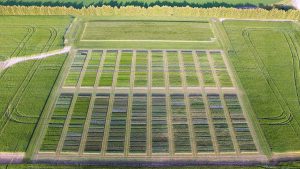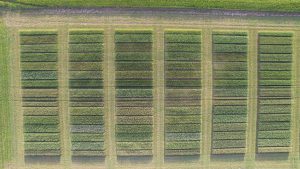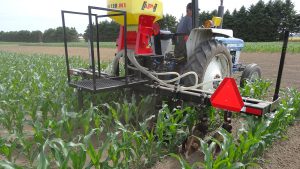New screening technology
AN ADVANTAGE FOR WHEAT BREEDERS

IN 2016, STATISTICS Canada anticipated that Canadian wheat production would decline by 19.5 per cent in 2017, attributing the decline to dry conditions in the prairies. But Western Canada isn’t the only region in the country suffering from drier conditions; drought can impact wheat production in Ontario as well. In the future, keeping wheat in the rotation will be dependent on access to more drought-resistant varieties. Scientists from Canadian Light Source (CLS) and researchers from the University of Saskatchewan have developed a new technique to examine drought tolerance in wheat and are working to solve the problem now.
Karen Tanino, a plant physiologist from the University of Saskatchewan, teamed up with Chithra Karunakaran, science manager at CLS, and using a synchrotron they developed a simple and non-destructive method to screen hundreds of wheat leaf samples in a day.
SCREENING
Karunakaran explained how the synchrotron works. Basically, a synchrotron is a bright light source that scientists use to collect information about the structural and chemical properties of materials at the molecular level. Researchers study their samples — in this case, wheat plants — by directing beams of the different spectra of light, including infrared, ultraviolet, and x-rays, onto their samples. Doing so allows them to observe the interaction between the light and the matter within their sample inside the comfort of the laboratory.
Specifically, the researchers used the wax of a flag leaf to examine the morphological characteristics of wheat plants, comparing two common varieties: Stettler, a drought-resistant variety, and Superb, which is more vulnerable under dry conditions. Doing so allowed them to make some startling discoveries.
One of Tanino’s students looked at the rate of leaf rolling. The rolling rate of the leaf on the drought-resistant Stettler was faster than it was in Superb. “We think that was related to the boliform cells, which were significantly larger in Stettler than they are in superb,” says Tanino.
Knowing this, breeders can avoid lines with smaller boliform cells if they know it contributes to leaf rolling and drought intolerance.
Using CLS, Tanino says they were able to look at the spectra of elements in the flag leaf, including zinc, magnesium, and calcium, of both Stettler and Superb. Zinc was of particular interest. To do this, researchers would normally have to grind up the tissue, put it through atomic absorption spectroscopy or inductively coupled plasma, both of which are very labour intensive.
“With this method, it’s non-destructive,” says Tanino. “We can conduct spatial localization where zinc is located and it’s also semi-quantitative.”
In fact, they look at relative levels between the two cultivars of most elements in the periodic table.
IMPORTANCE
Why is this important? Its importance lies in the fact that the researchers have been able to link micro and macronutrients in the leaves to their ability to tolerate drought, having found higher levels of zinc in the drought-resistant Stettler.
“The agriculture community knows that leaf wax plays a role in conserving water and acts as a physical barrier to disease,” explained Karunakaran. “But before this we hadn’t understood why that’s happening on a molecular level.”
While the research is currently focused on varieties perhaps more suited to western Canadian conditions, Ontario farmers gain from the research as well.
“I think that linking any phenotypic, measurable response to drought stress resistance would be useful, not only to Ontario, but to many regions across the world,” says Tanino. “Any time we can give breeders a tool to increase the efficiency of the selection of their plants, then that is always a plus.”
What makes this research particularly unique is that it starts in the field.
“Usually we think about lab-to-field, but this is field back to lab, and I think that is special because we’re basing our phenotyping on known cultivars that have been validated in the field by breeders,” says Tanino.
ONTARIO PERSPECTIVE
While Ontario is considered a humid climate, the province does get hit with drought nearly every year. “The big question mark is when does that period of drought hit,” says Peter Johnson, Real Agriculture agronomist.
Typically, the critical time for winter wheat in Ontario is the end of May to mid-June. The first two weeks of grain fill are the most important.
“There have been a number of years where I can recall writing in the crop report in late May that we were seeing drought symptomology, particularly on certain varieties,” says Johnson.
Light sand and heavier clay soils are particularly problematic when drought hits, as it is tougher to get the water out. The leaves, explained Johnson, will roll and spike up under these conditions. That rolling has long been a mystery to him, as he hasn’t seen data on what causes that.
“When that leaf rolls, that’s a drought response of the plant,” he says. “Some people say that’s a bad thing. Other people say well that’s actually a good thing because the plant is protecting itself and maybe it is better that its leaves roll early so that it is protecting itself and is healthy when the rain does come.”
Although he’s never been able to figure it out, he says his sense is that rolling is a sign that it’s just not as drought tolerant.
“So if you ask me if drought tolerance is an important feature in Ontario wheat production, the answer is absolutely,” says Johnson. “Do you know how hard it is for me to keep growers growing wheat when they get that one year with low yields? So it is important from an Ontario perspective.”
KEEPING WHEAT IN THE ROTATION
Peter Johnson’s top reasons why
- YIELD: On average, corn yields four per cent higher and soybeans yield 11 per cent higher when wheat is in the rotation.
- YIELD STABILITY: Fields with wheat in the rotation are much more able to withstand stress conditions and maintain yield.
- SOIL HEALTH: Fields with wheat included have higher organic matter, better structure, and sequester more carbon, even when you bale the straw and do not grow a cover crop.
- COVER CROPS: Wheat provides the ideal opportunity to include cover crops to improve your soil.
- SOIL AMENDMENTS: From lime to manure, bio-solids to compost, wheat offers the best window to apply soil amendments and they won’t damage the soil.
- EMERGENCY FORAGE: You can grow emergency forage after the wheat crop and still see a soil health benefit from the roots of the emergency forage.
- STRAW: If you need fiber in the ration, bedding, or just need extra cash, you can sell the straw.
- WEED CONTROL: No other crop gives you the options for summer/early fall herbicide applications, and you open the doors to almost every mode of action available.
- SPREADS WORKLOAD: Growing wheat means you get to keep the combine in the field for an extra week or two in summer.
- SPREADS RISK: With different timing for wheat grain fills, the crop is exposed to different weather and provides different marketing opportunities.
- BREAKS DISEASE CYCLES: Growing wheat prevents crop specific diseases from continuing year to year. •

























